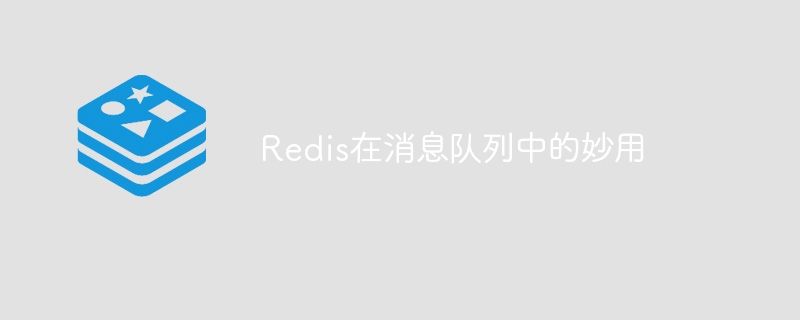
The wonderful use of Redis in message queue
Message queue is a common decoupled architecture used to deliver asynchronous messages between applications. By sending a message to a queue, the sender can continue performing other tasks without waiting for a response from the receiver. And the receiver can get the message from the queue and process it at the appropriate time.
Redis is a commonly used open source in-memory database with high performance and persistent storage capabilities. In message queues, Redis's multiple data structures and excellent performance make it an ideal choice. This article will introduce the wonderful use of Redis in message queues and give corresponding code examples.
We can implement a simple queue through the List data structure of Redis. The following is a sample code for a producer to send messages to the queue and a consumer to get messages from the queue:
Producer code:
import redis
redis_host = 'localhost'
redis_port = 6379
queue_name = 'my_queue'
def produce_message(message):
r = redis.Redis(host=redis_host, port=redis_port)
r.lpush(queue_name, message)
message = 'Hello, Redis!'
produce_message(message)Consumer code:
import redis
redis_host = 'localhost'
redis_port = 6379
queue_name = 'my_queue'
def consume_message():
r = redis.Redis(host=redis_host, port=redis_port)
message = r.rpop(queue_name)
if message:
print(f'Received message: {message.decode()}')
else:
print('No message in the queue.')
consume_message()The publish/subscribe model of Redis can be implemented by using its Pub/Sub function. The following is a sample code for a publisher to publish a message to a specific channel and have multiple subscribers receive the message:
Publisher code:
import redis
redis_host = 'localhost'
redis_port = 6379
channel_name = 'my_channel'
message = 'Hello, subscribers!'
def publish_message():
r = redis.Redis(host=redis_host, port=redis_port)
r.publish(channel_name, message)
publish_message()Subscriber code:
import redis
redis_host = 'localhost'
redis_port = 6379
channel_name = 'my_channel'
def handle_message(message):
print(f'Received message: {message["data"].decode()}')
def subscribe_channel():
r = redis.Redis(host=redis_host, port=redis_port)
p = r.pubsub()
p.subscribe(channel_name)
for message in p.listen():
if message['type'] == 'message':
handle_message(message)
subscribe_channel()Delay queue is a common application scenario, used to process tasks that need to be executed after a certain period of time. Through Redis's Sorted Set data structure, we can implement a simple delay queue. The following is an example code where a producer puts a message into a delay queue and a consumer gets the message after a specific time:
Producer code:
import redis
import time
redis_host = 'localhost'
redis_port = 6379
delayed_queue_name = 'my_delayed_queue'
message = 'Hello, delayed queue!'
delay_time = time.time() + 10 # 10秒延迟
def produce_message(message, delay_time):
r = redis.Redis(host=redis_host, port=redis_port)
r.zadd(delayed_queue_name, {message: delay_time})
produce_message(message, delay_time)Consumer code:
import redis
import time
redis_host = 'localhost'
redis_port = 6379
delayed_queue_name = 'my_delayed_queue'
def consume_message():
r = redis.Redis(host=redis_host, port=redis_port)
current_time = time.time()
messages = r.zrangebyscore(delayed_queue_name, 0, current_time)
if messages:
for message in messages:
print(f'Received message: {message.decode()}')
r.zrem(delayed_queue_name, message)
else:
print('No message in the delayed queue.')
consume_message()Through the above code examples, we can see the wonderful use of Redis in message queues. Using the data structures and functions of Redis, we can easily implement common message queue functions such as simple queues, publish/subscribe patterns, and delay queues. The high performance and scalability of Redis also make it an ideal message queue solution.
The above is the detailed content of The wonderful use of Redis in message queue. For more information, please follow other related articles on the PHP Chinese website!
 Commonly used database software
Commonly used database software
 What are the in-memory databases?
What are the in-memory databases?
 Which one has faster reading speed, mongodb or redis?
Which one has faster reading speed, mongodb or redis?
 How to use redis as a cache server
How to use redis as a cache server
 How redis solves data consistency
How redis solves data consistency
 How do mysql and redis ensure double-write consistency?
How do mysql and redis ensure double-write consistency?
 What data does redis cache generally store?
What data does redis cache generally store?
 What are the 8 data types of redis
What are the 8 data types of redis




